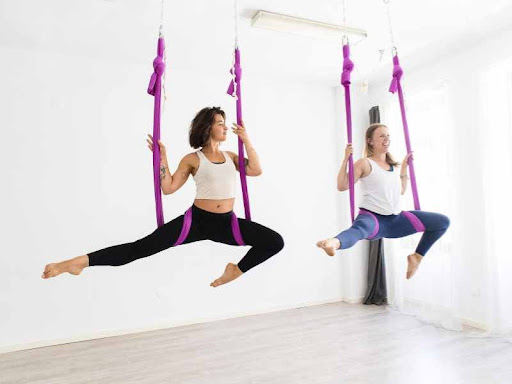
Yoga has evolved over the years from an ancient spiritual practice to a mainstream wellness movement. And aerial yoga is one of its most exciting modern incarnations. Combining traditional yoga with acrobatics, aerial yoga takes place in a soft, fabric hammock suspended from the ceiling. This innovative prop allows for dynamic new poses and greater mobility as you float, swing, and invert with newfound freedom.
But if you’re new to aerial arts, you probably have questions about how to start and what to expect. As most aerial yoga studios add beginner aerial classes to their schedules, beginners are understandably curious and perhaps a bit apprehensive to take the plunge.
In this beginner’s guide to aerial yoga, we’ll cover everything you need to know about this gravity-defying practice. By the end, both newbies and seasoned yogis alike will understand how to approach aerial yoga to maximize safety, comfort, and enjoyment.
What is Aerial Yoga?

Aerial yoga, also known as anti-gravity yoga, is a dynamic and innovative form of yoga that combines traditional yoga poses, Pilates, and dance with a hammock. This distinctive form of yoga allows practitioners to perform postures that they may not ordinarily be able to achieve on the yoga mat. The hammock, a key element in aerial yoga, is a fabric swing or sling suspended from the ceiling or a rig. It supports the body’s weight, enables easier movement, and allows for a wider range of motion.
In aerial yoga, the hammock acts as a soft trapeze, supporting the hips for forward bends and backbends, or wrapping around the body for other poses. This unique setup allows for a full-body workout that combines strength training, flexibility, and balance. Aerial yoga practitioners often report a feeling of freedom as they float through the air, an experience that distinguishes it significantly from traditional yoga practices.
Suitable for all ages and fitness levels, aerial yoga offers modifications for different skill sets. This ensures a safe and accessible experience for beginners and challenging enough variations for more advanced practitioners.
History of Aerial Yoga
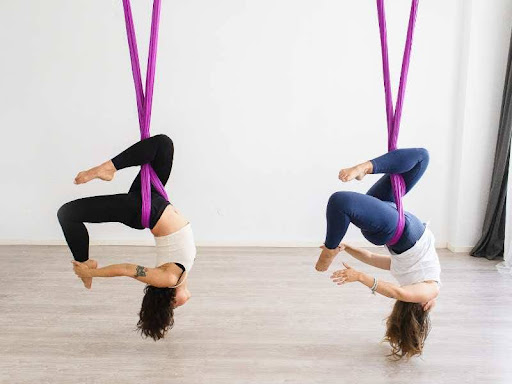
The history of aerial yoga is a fascinating blend of traditional yoga principles and modern acrobatics. It was developed in the early 2000s by Christopher Harrison, a former gymnast and Broadway dancer. Harrison, with his extensive background in dance and aerial arts, sought to create a practice that combined the grace and agility of aerial acrobatics with the mindfulness and holistic health benefits of yoga.
His creation, “Anti-Gravity Yoga,” was introduced in New York City. Harrison’s concept was revolutionary: it involved the use of a silk hammock suspended from the ceiling, allowing practitioners to perform yoga poses while partially or fully off the ground.
The inspiration for aerial yoga came from multiple sources. Traditional yoga practices, particularly those emphasizing alignment and breath control, play a significant role. The therapeutic benefits of inversion therapy, which involves hanging upside down or at an inverted angle to relieve spinal pressure, were integrated into the practice. Harrison’s background in gymnastics and aerial arts also contributed to the development of more dynamic and acrobatic elements in aerial yoga.
As the practice evolved, various forms of aerial yoga emerged, each adding its own twist to the original concept. Some aerial yoga studios focused more on yoga’s meditative and relaxing aspects, while others incorporated more vigorous and acrobatic movements for a high-intensity workout. Aerial yoga is practiced worldwide and has become a staple in yoga studios and fitness centers that offer aerial yoga.
Why You Will Love Aerial Yoga
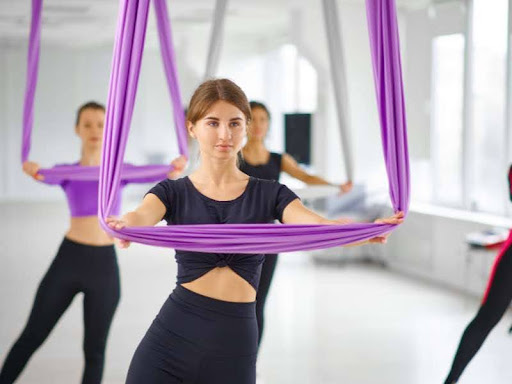
- Playful and Fun: Aerial yoga can add a playful element to the traditional yoga practice, making it an enjoyable and exciting aerial workout.
- Enhances Flexibility and Strength: The hammock aids in deeper stretches and strengthening muscles without strain.
- Stress Relief: The gentle swinging motion of the hammock is calming and can help reduce stress.
- Accessible to All Levels: With the support of the hammock, aerial yoga can be adapted for all skill levels.
- Inversion Therapy: Being upside down can help improve blood flow and decompress the spine.
How is Aerial Yoga Different?
Aerial yoga class, also known as antigravity yoga, differs from traditional yoga in that it incorporates a hammock or silk that suspends you from the ground. This key difference allows for a greater range of motion, deeper stretches, and the ability to perform gravity-defying poses that can be challenging on the mat.
Can you Start Aerial Yoga at Home?

Starting aerial yoga at home is possible with the right setup and equipment. It’s important to ensure you have enough space and a secure attachment point for the hammock. Begin with basic poses before moving on to more advanced techniques. It’s also advisable to attend aerial yoga classes first to become fully comfortable doing it at home.
Aerial Yoga Equipment You Need
Aerial yoga requires the right equipment for safe and effective practice.
- Aerial Hammock or Yoga Swing
Material: High-strength, low-stretch fabric such as parachute silk or a polyester-nylon blend.
Features: Should be soft, durable, and capable of supporting body weight.
Purpose: Serves as the primary tool for aerial yoga, supporting various poses and exercises. - Rigging Equipment
Carabiners and Daisy Chains: Used for suspending the hammock from the ceiling and adjusting its height.
Ceiling Mounts or Beams: Essential for a secure attachment point to the ceiling.
Free-Standing Aerial Rigs: An alternative for those who prefer not to install mounts in the ceiling, though they require more space. - Yoga Mat
Place beneath the hammock for additional support during floor-based stretches and poses. The yoga mat adds a layer of safety and comfort. - Appropriate Clothing
You can wear snug-fitting, stretchy fabrics that cover sensitive areas like the back of the knees and upper arms. The right clothing protects against fabric burn and ensures smooth movement without getting caught in the hammock. - Accessories
It’s essential to remove your jewelry to prevent snagging or tearing the hammock fabric. For those with long hair, use a hair tie to prevent tangling during movements.

This equipment checklist is designed to enhance your aerial yoga experience, prioritizing safety, comfort, and efficiency. Quality equipment not only ensures a safe practice but also enriches the overall aerial yoga experience. This allows you to focus fully on your practice and enjoy the unique physical and mental benefits of aerial yoga.
Benefits of Aerial Yoga Class

Aerial yoga offers many potential benefits, ranging from physical improvements to mental well-being. Here is an expanded look at the specific benefits this unique yoga form provides:
Improved Flexibility and Mobility
Aerial yoga can help in stretching and strengthening muscles and joints, leading to improved flexibility. The support of the hammock allows you to move more freely and achieve a greater range of motion, facilitating deeper stretches in aerial fitness than in traditional yoga.
Enhanced Core Strength
Engaging in aerial yoga requires the use of core muscles to stabilize and balance in the hammock. This constant engagement strengthens the core muscles, which are crucial for good posture and overall body strength.
Stress Reduction
Aerial yoga’s playful and uplifting nature, combined with deep breathing techniques and movement, significantly reduces stress according to a study. The gentle rocking motion of the hammock can also have a soothing, meditative effect, helping to calm the mind and reduce anxiety.
Spinal Decompression
Inversions in aerial yoga can allow the spine to lengthen, which can help decompress and hydrate your spinal discs. This is particularly beneficial for individuals who suffer from back pain or spinal compression issues.
Low-Impact Cardiovascular Conditioning
While it may not seem as intense as other forms of exercise, aerial yoga can provide a low-impact cardiovascular workout. The effort required to maneuver and balance in the hammock raises the heart rate, improving cardiovascular health.
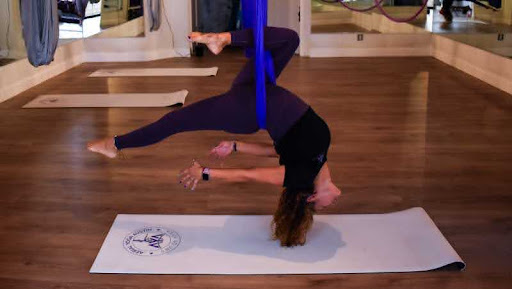
Improved Balance and Proprioception
Practicing aerial yoga enhances proprioception (the awareness of the body in space) and improves balance. The instability of the hammock forces the body to develop a deeper sense of body alignment and balance.
Increased Muscular Flexibility and Joint Mobility
The hammock aids in safely exploring a wide range of movements, which can lead to increased flexibility and joint mobility, reducing the risk of injury in daily activities.
Lymphatic System Stimulation and Detoxification
The movements and inversions in aerial yoga help stimulate the lymphatic system, which plays a key role in immune function and detoxification of the body.
Adaptability and Mental Clarity
Engaging in the new physical challenges and movements of aerial yoga can stimulate the brain, promoting neuroplasticity, which is the brain’s ability to form new neural connections, potentially enhancing mental acuity and cognitive function.
Fun and Creativity
Aerial yoga offers a unique and enjoyable experience. It encourages creativity and playfulness, which can be a refreshing change from traditional exercise routines, boosting overall well-being and mental health.
By incorporating aerial yoga into your fitness regime, you can enjoy these extensive benefits, contributing not only to physical health but also to mental and emotional well-being. The combination of traditional yoga principles with the dynamic aspects of aerial movement creates a holistic practice that nourishes the body, mind, and spirit.
Tips for Beginners in Aerial Yoga
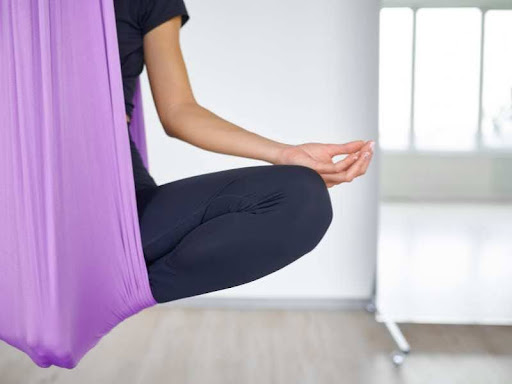
Starting aerial yoga can be exciting, but it’s important to approach it with care and awareness. Here are some detailed tips for beginners to ensure a safe and enjoyable experience:
Choose the Right Class: Start with a beginner-friendly class. These classes focus on fundamental poses and techniques, ensuring a solid foundation.
Arrive Early and Communicate with the Instructor: Arriving early gives you time to get comfortable with the space and equipment. Use this time to inform the instructor of any injuries, concerns, or fears you might have.
Focus on Breathing: Just like traditional yoga, breathing is a vital part of aerial yoga. Concentrate on your breath to help maintain balance and flow through movements smoothly. Deep, steady breathing can also aid relaxation and focus.
Get Comfortable with the Hammock: Spend some time getting to know the hammock – how it feels, how to grip it, and how it supports your weight. Trusting the hammock is the key to enjoying aerial yoga.
Listen to Your Body: Pay attention to how your entire body feels during the pose. If something hurts or feels wrong, gently come out of the pose. It’s important to distinguish between good pain (mild discomfort from stretching) and bad pain (sharp or damaging pain).
Don’t Rush into Inversions: Inversions are a big part of aerial yoga, but they can be intimidating for beginners. Build up to them slowly, starting with partial inversions, and always follow your instructor’s guidance.
Dress Appropriately: Wear form-fitting, stretchy clothing that covers the armpits and legs. Loose clothing can get tangled in the hammock, and exposed skin might get pinched. Remove jewelry, watches, and anything else that could catch on the fabric.
Stay Hydrated: Bring a water bottle and take breaks to drink, especially if you’re doing a more physically demanding class.
Practice Regularly: Consistency is key to aerial class yoga. Regular practice helps your body adjust to the new movements and poses, building strength and confidence over time.
Have an Open Mind and Be Patient: Aerial classes can be challenging, but also incredibly rewarding. Be patient with yourself as you learn and be open to the experience.
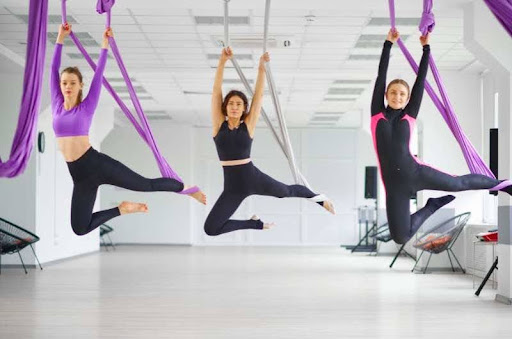
In Summary
Aerial yoga compares favorably to traditional yoga by offering a unique blend of strength, flexibility, and mindfulness, enhanced by the playful and innovative use of the aerial hammock. While the floating hammock may seem intimidating at first, this beginner’s guide breaks down everything you need to know to try aerial yoga.
We covered the origins of aerial yoga and how it combines yoga, dance, and inversion therapy for a uniquely gravity-defying experience. You learned about essential equipment, from durable hammocks, to rigging systems, and appropriate stretchy clothing. With the right setup and precautions, it’s even possible to practice aerial yoga at home for those eager to float on their own schedule.
From physical benefits like spinal decompression to mental perks like stress relief, aerial yoga has potential benefits to offer students of all levels. Follow the tips for beginners, from choosing an aerial yoga introductory class to pacing yourself with the poses, and you’ll be inverting with the best of them in no time.